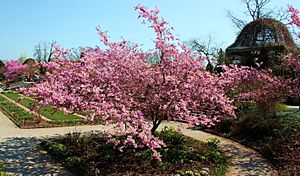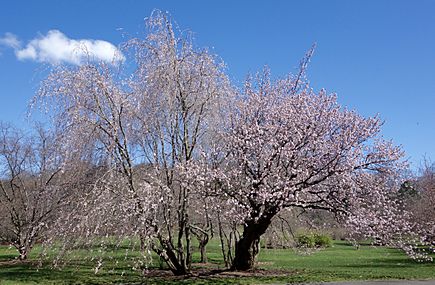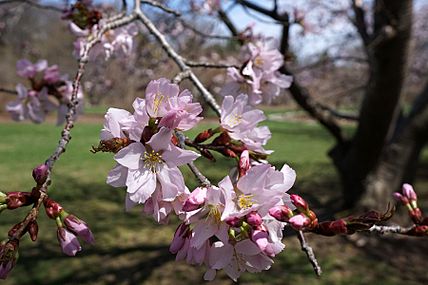Sargent's cherry facts for kids
Quick facts for kids Sargent's cherry |
|
|---|---|
 |
|
| Conservation status | |
| Scientific classification | |
| Synonyms | |
|
Prunus sargentii, often called Sargent's cherry or North Japanese hill cherry, is a type of cherry tree. It grows naturally in Japan, Korea, and Sakhalin (which is part of Russia). This tree was named after a person called Charles Sprague Sargent.
Contents
What Does Sargent's Cherry Look Like?
Sargent's cherry is a deciduous tree. This means it loses its leaves every fall. It can grow quite tall, reaching about 6 to 12 meters (20 to 40 feet) high and wide.
When new leaves first appear, they have a reddish or bronze color. Later, they turn into a shiny, dark green. The leaves are shaped like an upside-down egg, which is called obovate. They also have jagged edges, known as serrated margins. Each leaf is about 7 to 13 centimeters (3 to 5 inches) long. They are arranged one after another along the branch.
In the fall, these leaves change color again. They can turn bright red, orange, or yellow. This makes the tree very beautiful.
The tree produces single pink flowers. Each flower grows on a small stem about 2.5 centimeters (1 inch) long, called a pedicel. After the flowers bloom, small, dark purple-black fruits appear in the summer. These fruits are about the size of a pea. Birds love to eat them, but they are not very noticeable to people because they are so small and dark.
Growing and Caring for Sargent's Cherry Trees
Sargent's cherry is a popular tree to plant for its beauty. It grows quickly and needs a sunny spot to thrive. The soil should drain water well, so the roots don't get too wet.
This tree can handle windy conditions. However, it does not do well with air pollution. It is one of the toughest cherry trees and can be moved easily from one place to another. Because of this, it's often planted along streets. The tree can also go for some time without much water, meaning it is moderately drought-tolerant.
History of Sargent's Cherry
Sargent's cherry trees originally came from Korea and Japan. They were brought to America in 1908. Later that same year, they were also introduced to the United Kingdom.
Images for kids
See also
 In Spanish: Prunus sargentii para niños
In Spanish: Prunus sargentii para niños








